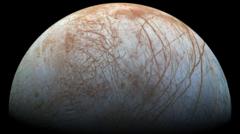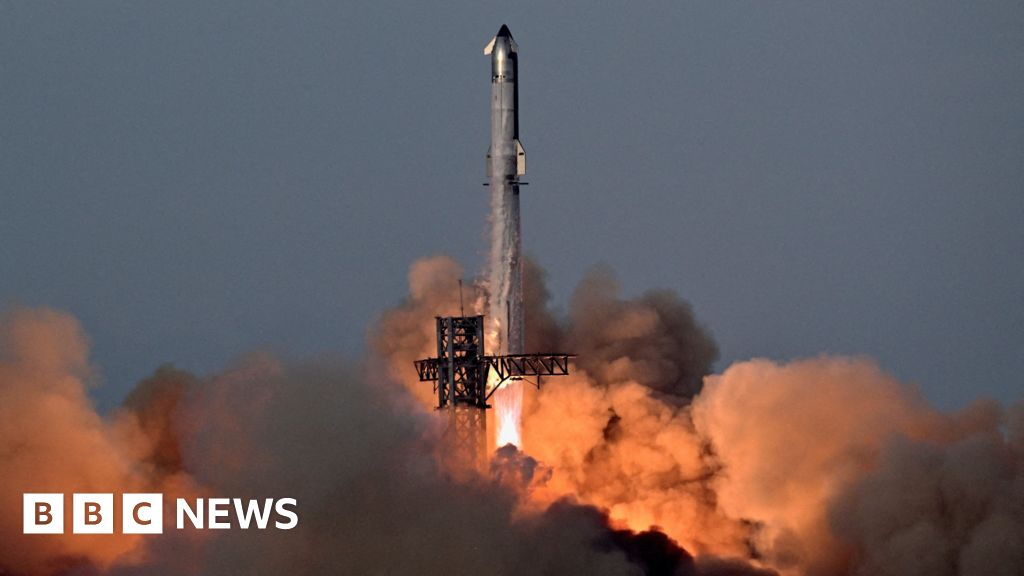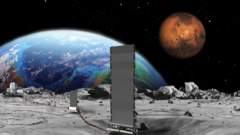In a matter of hours, NASA's Europa Clipper mission is set to launch from Cape Canaveral, Florida, setting off on an ambitious quest to uncover signs of alien life on Europa, one of Jupiter's moons. The decision to proceed follows a short delay caused by Hurricane Milton, which threatened the Florida coast and prompted engineers to conduct safety inspections of the launchpad. Once clear, the scheduled lift-off at 12:06 local time on October 14 indicates the beginning of a seven-year journey across our solar system.
Europa, despite being only slightly larger than Earth's moon, catches scientists' intrigue due to its potential for harboring life. Beneath its ice-covered surface, which reflects sunlight and shines brightly, scientists believe lies an enormous ocean that may contain twice the amount of water on Earth. This ocean, possibly rich in minerals and simple life-sustaining chemicals, fuels hopes of discovering extraterrestrial life.
Since the 1970s, telescopic observations and subsequent spacecraft explorations have hinted at Europa's life-supporting conditions. The Galileo spacecraft captured detailed images of its curious surface marked by dark streaks and plumes thought to be composed of salty water under the icy crust. These findings have laid the groundwork for the Clipper's expansive mission, which aims to map Europa's surface and study its ejected water plumes.
A collaborative international team, led by experts from NASA, the Jet Propulsion Lab, and other scientific institutions, will oversee Clipper's operations. They emphasize the mission's focus on understanding Europa's habitability by identifying the presence of water, heat, organic material, and their stability over time. Special instruments, like lasers to probe the ice, are designed to operate despite the harsh radiation that bombards the spacecraft during its close flybys of Europa. Sheltered electronic instruments reflect these challenges, highlighting the mission's complexity and innovation.
The Europa Clipper, the largest spacecraft ever to be deployed to a planetary body, will undertake a gravity-assisted voyage utilizing Earth's and Mars's gravity. This technique propels the spacecraft on its 1.8 billion-mile journey, eventually finding it overtaking the JUICE spacecraft from the European Space Agency on its way toward Europa as part of a mission to another of Jupiter's moons, Ganymede.
Upon its arrival in 2030, the Clipper's team hopes to delineate potential landing sites for future missions by understanding Europa's surface topography and composition better. While scientists remain cautious, aware that encounters on Europa may not reveal human-like life forms, Professor Michelle Dougherty from Imperial College, London, underscores the mission's greater goal as a journey of exploration and humanity's insatiable curiosity.
Professor Mark Fox-Powell encapsulates the mission's essence, distinct in its pursuit of knowledge rather than profit, drawing explorers deeper into the mysteries of our cosmic neighborhood in hopes of finding our place in the universe anew.
Europa, despite being only slightly larger than Earth's moon, catches scientists' intrigue due to its potential for harboring life. Beneath its ice-covered surface, which reflects sunlight and shines brightly, scientists believe lies an enormous ocean that may contain twice the amount of water on Earth. This ocean, possibly rich in minerals and simple life-sustaining chemicals, fuels hopes of discovering extraterrestrial life.
Since the 1970s, telescopic observations and subsequent spacecraft explorations have hinted at Europa's life-supporting conditions. The Galileo spacecraft captured detailed images of its curious surface marked by dark streaks and plumes thought to be composed of salty water under the icy crust. These findings have laid the groundwork for the Clipper's expansive mission, which aims to map Europa's surface and study its ejected water plumes.
A collaborative international team, led by experts from NASA, the Jet Propulsion Lab, and other scientific institutions, will oversee Clipper's operations. They emphasize the mission's focus on understanding Europa's habitability by identifying the presence of water, heat, organic material, and their stability over time. Special instruments, like lasers to probe the ice, are designed to operate despite the harsh radiation that bombards the spacecraft during its close flybys of Europa. Sheltered electronic instruments reflect these challenges, highlighting the mission's complexity and innovation.
The Europa Clipper, the largest spacecraft ever to be deployed to a planetary body, will undertake a gravity-assisted voyage utilizing Earth's and Mars's gravity. This technique propels the spacecraft on its 1.8 billion-mile journey, eventually finding it overtaking the JUICE spacecraft from the European Space Agency on its way toward Europa as part of a mission to another of Jupiter's moons, Ganymede.
Upon its arrival in 2030, the Clipper's team hopes to delineate potential landing sites for future missions by understanding Europa's surface topography and composition better. While scientists remain cautious, aware that encounters on Europa may not reveal human-like life forms, Professor Michelle Dougherty from Imperial College, London, underscores the mission's greater goal as a journey of exploration and humanity's insatiable curiosity.
Professor Mark Fox-Powell encapsulates the mission's essence, distinct in its pursuit of knowledge rather than profit, drawing explorers deeper into the mysteries of our cosmic neighborhood in hopes of finding our place in the universe anew.


















